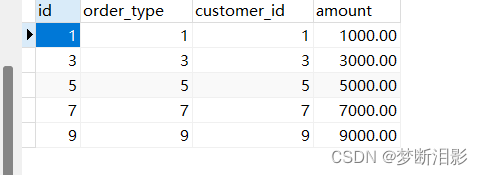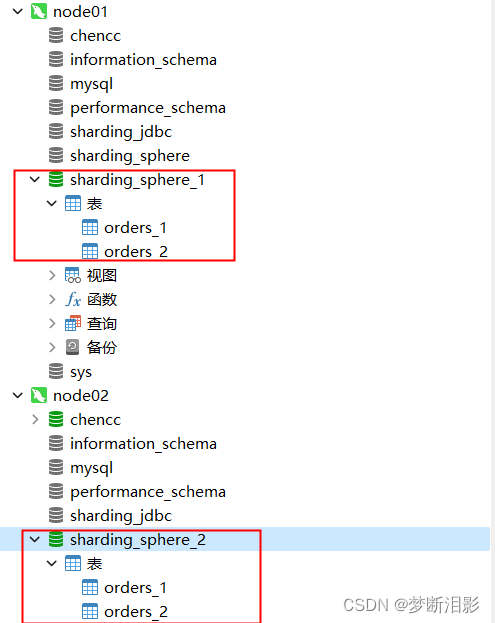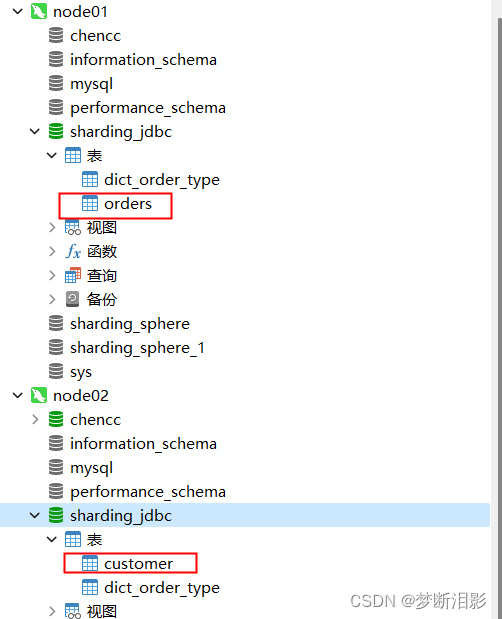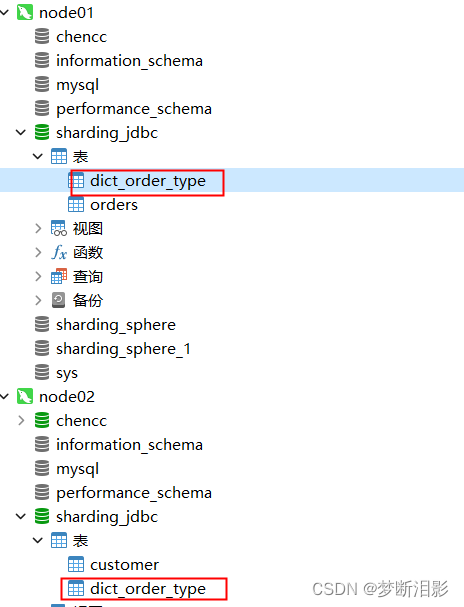1. 介绍
Sharding-JDBC是ShardingSphere的第一个产品,也是ShardingSphere的前身。 它定位为轻量级Java框架,在Java的JDBC层提供的额外服务。它使用客户端直连数据库,以jar包形式提供服务,无需额外部署和依赖,可理解为增强版的JDBC驱动,完全兼容JDBC和各种ORM框架。
- 适用于任何基于JDBC的ORM框架,如:JPA, Hibernate, Mybatis, Spring JDBC Template或直接使用JDBC。
- 支持任何第三方的数据库连接池,如:DBCP, C3P0, BoneCP, Druid, HikariCP等。
- 支持任意实现JDBC规范的数据库。目前支持MySQL,Oracle,SQLServer,PostgreSQL以及任何遵循SQL92标准的数据库。
2. 构建一个springboot项目
<?xml version="1.0" encoding="UTF-8"?>
<project xmlns="http://maven.apache.org/POM/4.0.0" xmlns:xsi="http://www.w3.org/2001/XMLSchema-instance"
xsi:schemaLocation="http://maven.apache.org/POM/4.0.0 https://maven.apache.org/xsd/maven-4.0.0.xsd">
<modelVersion>4.0.0</modelVersion>
<parent>
<groupId>org.springframework.boot</groupId>
<artifactId>spring-boot-starter-parent</artifactId>
<version>2.7.1</version>
<relativePath/> <!-- lookup parent from repository -->
</parent>
<groupId>com.sharding.jdbc</groupId>
<artifactId>shardingjdbc</artifactId>
<version>0.0.1-SNAPSHOT</version>
<name>shardingjdbc</name>
<description>Demo project for Spring Boot</description>
<properties>
<java.version>11</java.version>
</properties>
<dependencies>
<dependency>
<groupId>org.springframework.boot</groupId>
<artifactId>spring-boot-starter</artifactId>
</dependency>
<dependency>
<groupId>org.springframework.boot</groupId>
<artifactId>spring-boot-starter-jdbc</artifactId>
</dependency>
<dependency>
<groupId>org.mybatis.spring.boot</groupId>
<artifactId>mybatis-spring-boot-starter</artifactId>
<version>2.1.3</version>
</dependency>
<dependency>
<groupId>com.alibaba</groupId>
<artifactId>druid</artifactId>
<version>1.1.23</version>
</dependency>
<dependency>
<groupId>org.apache.shardingsphere</groupId>
<artifactId>sharding-jdbc-spring-boot-starter</artifactId>
<version>4.1.1</version>
</dependency>
<dependency>
<groupId>mysql</groupId>
<artifactId>mysql-connector-java</artifactId>
<scope>runtime</scope>
</dependency>
<dependency>
<groupId>org.springframework.boot</groupId>
<artifactId>spring-boot-starter-test</artifactId>
<scope>test</scope>
<exclusions>
<exclusion>
<groupId>org.junit.vintage</groupId>
<artifactId>junit-vintage-engine</artifactId>
</exclusion>
</exclusions>
</dependency>
<dependency>
<groupId>org.projectlombok</groupId>
<artifactId>lombok</artifactId>
</dependency>
</dependencies>
<build>
<plugins>
<plugin>
<groupId>org.springframework.boot</groupId>
<artifactId>spring-boot-maven-plugin</artifactId>
</plugin>
<plugin>
<groupId>org.apache.maven.plugins</groupId>
<artifactId>maven-surefire-plugin</artifactId>
<configuration>
<skipTests>true</skipTests>
</configuration>
</plugin>
</plugins>
</build>
</project>
3. 水平分表
- 在node01(192.168.109.132)上创建sharding_sphere数据库
- 在数据库中创建两张表,orders_1和orders_2
CREATE TABLE `orders_1` (
`id` int(11) NOT NULL AUTO_INCREMENT,
`order_type` int(11) DEFAULT NULL,
`customer_id` int(11) DEFAULT NULL,
`amount` decimal(10,2) DEFAULT NULL,
PRIMARY KEY (`id`)
) ENGINE=InnoDB AUTO_INCREMENT=1 DEFAULT CHARSET=utf8mb4;
CREATE TABLE `orders_2` (
`id` int(11) NOT NULL AUTO_INCREMENT,
`order_type` int(11) DEFAULT NULL,
`customer_id` int(11) DEFAULT NULL,
`amount` decimal(10,2) DEFAULT NULL,
PRIMARY KEY (`id`)
) ENGINE=InnoDB AUTO_INCREMENT=1 DEFAULT CHARSET=utf8mb4;

- 分片规则:如果订单编号是偶数添加到orders_1,如果是奇数添加到orders_2
- 创建配置文件
spring:
shardingsphere:
datasource:
#配置数据源的名称
names: ds1
#配置数据源的具体内容
ds1:
driver-class-name: com.mysql.jdbc.Driver
password: 123456
type: com.alibaba.druid.pool.DruidDataSource
url: jdbc:mysql://192.168.109.132:3306/sharding_sphere?serverTimezone=UTC
username: root
sharding:
tables:
#指定orders表的分布情况,配置表在哪个数据库中,表名称是什么
orders:
actual-data-nodes: ds1.orders_$->{1..2}
#指定orders表里主键id生成策略
key-generator:
column: id
type: SNOWFLAKE
#指定分片策略。根据id的奇偶性来判断插入到哪个表
table-strategy:
inline:
algorithm-expression: orders_${id%2+1}
sharding-column: id
#打开sql输出日志
props:
sql:
show: true
#开启驼峰
mybatis:
configuration:
map-underscore-to-camel-case: true
- 创建实体类
@Data
public class Orders implements Serializable {
private Integer id;
private Integer orderType;
private Integer customerId;
private Double amount;
}
- 创建dao
public interface OrdersDao {
@Insert("insert into orders(id,order_type,customer_id,amount) values(#{id},#{orderType},#{customerId},#{amount})")
void insert(Orders orders);
@Select("select * from orders where id = #{id}")
public Orders selectOne(Integer id);
}
- 创建测试类
@SpringBootTest
public class ShardingJdbcApplicationTests {
@Resource
private OrdersDao ordersDao;
@Test
public void addOrders(){
for (int i = 1; i <=10 ; i++) {
Orders orders = new Orders();
orders.setId(i);
orders.setCustomerId(i);
orders.setOrderType(i);
orders.setAmount(1000.0*i);
ordersDao.insert(orders);
}
}
@Test
public void queryOrders(){
Orders orders = ordersDao.selectOne(1);
System.out.println(orders);
}
}
- 结果

orders_1:

orders_2:

4. 水平分库
-
在不同的数据节点node01,node02上创建不同名称的数据库:sharding_sphere_1,sharding_sphere_2
-
在两个数据库上创建相同的表orders_1,orders_2

-
分片规则,按照customer_id的奇偶性来进行分库,然后按照id的奇偶性进行分表
-
配置文件
spring:
shardingsphere:
datasource:
#配置数据源的名称
names: ds1,ds2
#配置数据源的具体内容
ds1:
driver-class-name: com.mysql.jdbc.Driver
password: 123456
type: com.alibaba.druid.pool.DruidDataSource
url: jdbc:mysql://192.168.109.132:3306/sharding_sphere_1?serverTimezone=UTC
username: root
ds2:
driver-class-name: com.mysql.jdbc.Driver
password: 123456
type: com.alibaba.druid.pool.DruidDataSource
url: jdbc:mysql://192.168.109.128:3306/sharding_sphere_2?serverTimezone=UTC
username: root
sharding:
tables:
#指定orders表的分布情况,配置表在哪个数据库中,表名称是什么
orders:
actual-data-nodes: ds$->{1..2}.orders_$->{1..2}
#指定orders表里主键id生成策略
key-generator:
column: id
type: SNOWFLAKE
#指定分片策略。根据id的奇偶性来判断插入到哪个表
table-strategy:
inline:
algorithm-expression: orders_${id%2+1}
sharding-column: id
#指定库分片策略,根据customer_id的奇偶性来添加到不同的库中
database-strategy:
inline:
algorithm-expression: ds$->{customer_id%2+1}
sharding-column: customer_id
#打开sql输出日志
props:
sql:
show: true
#开启驼峰
mybatis:
configuration:
map-underscore-to-camel-case: true
- 修改ordersDao
public interface OrdersDao {
@Insert("insert into orders(id,order_type,customer_id,amount) values(#{id},#{orderType},#{customerId},#{amount})")
void insert(Orders orders);
@Select("select * from orders where id = #{id}")
public Orders selectOne(Integer id);
@Select("select * from orders where id = #{id} and customer_id=#{customerId}")
public Orders selectOneDB(Orders orders);
}
- 测试类
@SpringBootTest
public class ShardingJdbcApplicationTests {
@Resource
private OrdersDao ordersDao;
@Test
public void addOrdersDB(){
for (int i = 1; i <=10 ; i++) {
Orders orders = new Orders();
orders.setId(i);
orders.setCustomerId(new Random().nextInt(10));
orders.setOrderType(i);
orders.setAmount(1000.0*i);
ordersDao.insert(orders);
}
}
@Test
public void queryOrdersDB(){
Orders orders = new Orders();
orders.setCustomerId(8);
orders.setId(7);
Orders o = ordersDao.selectOneDB(orders);
System.out.println(o);
}
}
5. 垂直分库
-
在不同的数据节点node01,node02创建相同的库sharding_jdbc
-
在node01上创建orders表,在node02上创建customer表

-
分片规则:将不同的表插入到不同的库中
-
配置文件
spring:
shardingsphere:
datasource:
#配置数据源的名称
names: ds1,ds2
#配置数据源的具体内容
ds1:
driver-class-name: com.mysql.jdbc.Driver
password: 123456
type: com.alibaba.druid.pool.DruidDataSource
url: jdbc:mysql://192.168.109.132:3306/sharding_jdbc?serverTimezone=UTC
username: root
ds2:
driver-class-name: com.mysql.jdbc.Driver
password: 123456
type: com.alibaba.druid.pool.DruidDataSource
url: jdbc:mysql://192.168.109.128:3306/sharding_jdbc?serverTimezone=UTC
username: root
sharding:
tables:
#配置orders表所在的数据节点
orders:
actual-data-nodes: ds1.orders
#指定orders表里主键id生成策略
key-generator:
column: id
type: SNOWFLAKE
#配置customer表所在的数据节点
customer:
actual-data-nodes: ds2.customer
#指定customer表里主键id生成策略
key-generator:
column: id
type: SNOWFLAKE
#打开sql输出日志
props:
sql:
show: true
#开启驼峰
mybatis:
configuration:
map-underscore-to-camel-case: true
- 编写customer类
@Data
public class Customer implements Serializable {
private Integer id;
private String name;
}
- 编写dao
public interface CustomerDao {
@Insert("insert into customer(id,name) values(#{id},#{name})")
public void insertCustomer(Customer customer);
}
- 测试类
@SpringBootTest
public class ShardingJdbcApplicationTests {
@Resource
private OrdersDao ordersDao;
@Resource
private CustomerDao customerDao;
@Test
public void addOrders(){
for (int i = 1; i <=10 ; i++) {
Orders orders = new Orders();
orders.setId(i);
orders.setCustomerId(i);
orders.setOrderType(i);
orders.setAmount(1000.0*i);
ordersDao.insert(orders);
}
}
@Test
public void insertCustomer(){
for (int i = 1; i <= 10 ; i++) {
Customer customer = new Customer();
customer.setId(i);
customer.setName("zs"+i);
customerDao.insertCustomer(customer);
}
}
}
6. 公共表
之前我们在学习mycat的时候接触过字典表的概念,其实在shardingsphere中也有类似的概念,只不过名字叫做公共表,也就是需要在各个库中都存在的表,方便做某些关联查询。
- 在不同节点的库上创建相同的表(node01,node02上创建dict_order_type)
CREATE TABLE `dict_order_type` (
`id` int(11) NOT NULL AUTO_INCREMENT,
`order_type` varchar(200) DEFAULT NULL,
PRIMARY KEY (`id`)
) ENGINE=InnoDB AUTO_INCREMENT=1 DEFAULT CHARSET=utf8mb4;

- 分片规则:公共表表示所有的库都具备相同的表
- 配置文件
spring:
shardingsphere:
datasource:
#配置数据源的名称
names: ds1,ds2
#配置数据源的具体内容
ds1:
driver-class-name: com.mysql.jdbc.Driver
password: 123456
type: com.alibaba.druid.pool.DruidDataSource
url: jdbc:mysql://192.168.109.132:3306/sharding_jdbc?serverTimezone=UTC
username: root
ds2:
driver-class-name: com.mysql.jdbc.Driver
password: 123456
type: com.alibaba.druid.pool.DruidDataSource
url: jdbc:mysql://192.168.109.128:3306/sharding_jdbc?serverTimezone=UTC
username: root
sharding:
#配置广播表
broadcast-tables: dict_order_type
tables:
dict_order_type:
#指定orders表里主键id生成策略
key-generator:
column: id
type: SNOWFLAKE
#打开sql输出日志
props:
sql:
show: true
#开启驼峰
mybatis:
configuration:
map-underscore-to-camel-case: true
- 创建实体类
@Data
public class DictOrderType {
private Integer id;
private String orderType;
}
- 创建dao
public interface DictOrderTypeDao {
@Insert("insert into dict_order_type(id,order_type) values(#{id},#{orderType})")
public void insertDictOrderType(DictOrderType dictOrderType);
@Delete("delete from dict_order_type where id = #{id}")
public void DeleteDictOrderType(Integer id);
}
- 测试类
@SpringBootTest
public class ShardingJdbcApplicationTests {
@Resource
private DictOrderTypeDao dictOrderTypeDao;
@Test
public void insertDictOrderType(){
for (int i = 1; i <= 10 ; i++) {
DictOrderType dictOrderType = new DictOrderType();
dictOrderType.setId(i);
dictOrderType.setOrderType("orderType"+i);
dictOrderTypeDao.insertDictOrderType(dictOrderType);
}
}
@Test
public void deleteDictOrderType(){
dictOrderTypeDao.DeleteDictOrderType(1);
}
}
7. 实现读写分离
- node03,node04配置主从复制
- 在node03上创建person表
CREATE TABLE `person` (
`id` int(11) NOT NULL AUTO_INCREMENT,
`name` varchar(200) DEFAULT NULL,
PRIMARY KEY (`id`)
) ENGINE=InnoDB DEFAULT CHARSET=utf8mb4;
- 配置文件
spring:
shardingsphere:
datasource:
#配置数据源的名称
names: ds1,ds2
#配置数据源的具体内容
ds1:
driver-class-name: com.mysql.jdbc.Driver
password: 123456
type: com.alibaba.druid.pool.DruidDataSource
url: jdbc:mysql://192.168.109.129:3306/chencc?serverTimezone=UTC
username: root
ds2:
driver-class-name: com.mysql.jdbc.Driver
password: 123456
type: com.alibaba.druid.pool.DruidDataSource
url: jdbc:mysql://192.168.109.130:3306/chencc?serverTimezone=UTC
username: root
masterslave:
name: ms
master-data-source-name: ds1
slave-data-source-names: ds2
#打开sql输出日志
props:
sql:
show: true
#开启驼峰
mybatis:
configuration:
map-underscore-to-camel-case: true
- 创建person类
@Data
public class Person implements Serializable {
private Integer id;
private String name;
}
- 创建dao
public interface PersonDao {
@Insert("insert into person(id,name) values(#{id},#{name})")
public void insertPerson(Person person);
@Select("select * from person where id = #{id}")
public Person queryPerson(Integer id);
}
- 测试类
@SpringBootTest
public class ShardingJdbcApplicationTests {
@Resource
private PersonDao personDao;
@Test
public void insertPerson(){
for (int i = 1; i <= 10; i++) {
Person person = new Person();
person.setId(i);
person.setName("zhangsan"+i);
personDao.insertPerson(person);
}
}
@Test
public void queryPerson(){
Person person = personDao.queryPerson(1);
System.out.println(person);
}
}






















 337
337











 被折叠的 条评论
为什么被折叠?
被折叠的 条评论
为什么被折叠?








